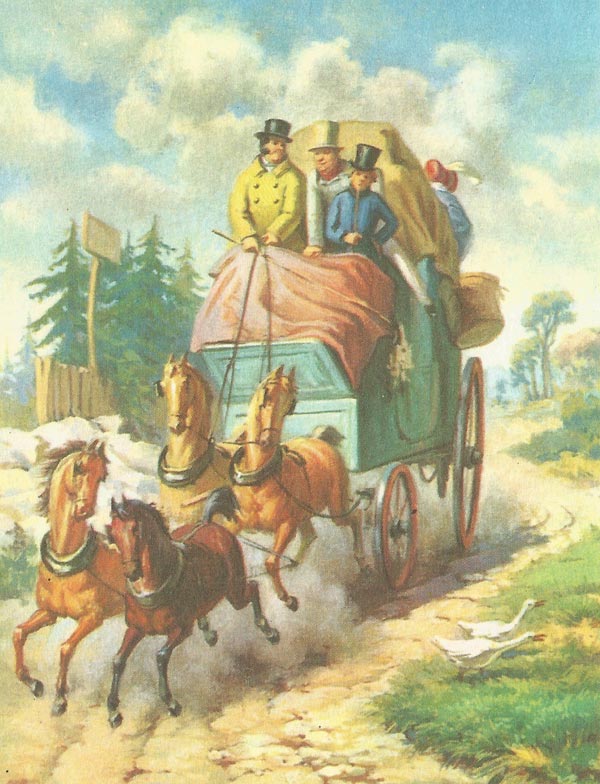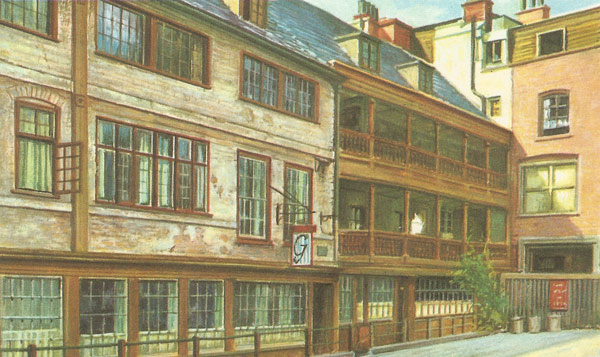coaching inns

A stage-coach as described by Charles Dickens in David Copperfield.

The George Inn at Southwark, London, famous throughout Kent and Sussex as a coaching and carriers' inn.
"Toot, toot, toot! The ostlers let go their heads, the four bays plunge at the collar, and away goes the Tally-Ho into the darkness, 45 seconds from the time they pulled up." That was how Tom Brown went off to start his school days at Rugby – by stage-coach from the Peacock Inn, Islington.
By the time Tom Brown and David Copperfield traveled by stage-coach this was a well-established form of public transport: "the Tally-Ho was a tip-top goer, 10 miles an hour including stoppages, and so punctual that all the road set their clocks by her."
The stage-coach first became an accepted method of traveling in about 1690, and by the early 18th century most of the large towns in England were linked with London by 'stage'. Certain inns were recognized stopping places for the change of horses and refreshment of the travelers. They catered not only for coach passengers but for the wealthy people who could afford their private carriages. The most expensive kind of public transport was the post-chaise. Then there was the royal mail for those who wanted to make good time on their journey.
Then, as now, the comfort offered by the inns would vary widely. Some were famous for their good food, quick service, and cleanliness. Others were equally well known for their exorbitant prices, bad food, and uncomfortable beds. Travelers often had to be up at three o'clock in the morning to be on the road for 12 hours, with only one stop for dinner (at about ten o'clock in the morning. Dishonest landlords sometimes took advantage of the limited time the travelers had for their dinner. The meal would be served late, and when the soup arrived it would be scalding hot. The diners would take so long to drink it that as the meat was brought in the guard would already be shouting for the passengers to take their seats in the coach once more. Bills would have to be paid, and the grumbling and still hungry passengers would be hurried away.
Nor was that the only kind of dishonesty. The staff of many of the coaching-inns were undoubtedly used as spies by highwaymen, and in some cases the inn-keeper himself was in league with thieves and murderers. It was easy enough to learn who was carrying large sums of money. On the next stage out from the inn, the highwaymen would be waiting in ambush, often knowing that the travelers' own pistols had been tampered with at their last stopping place.
An interesting social distinction was shown at the inn. 'First-class' passengers would have a private dining-room or would eat in the best parlor. Humbler passengers found themselves shown to the kitchen.
The coming of the railway
The beginning of the 19th century saw the start of the railway, and although it was feared at first as a most unsafe form of travel, it was soon to be popular. Travelers who still preferred to go by road rather than risk the roaring 'steam-horse' soon found that there were worse discomforts. The roads fell quickly into disrepair, inns became dilapidated from lack of custom, and there were fewer and fewer horses to take travelers on their next 'stage'. Inn-keepers became bankrupt, and many of the buildings fell into ruin.
But there are still a number of these famous old inns left. The arched entrances lead off the street into the old stable yards – these have often now been roofed over.
